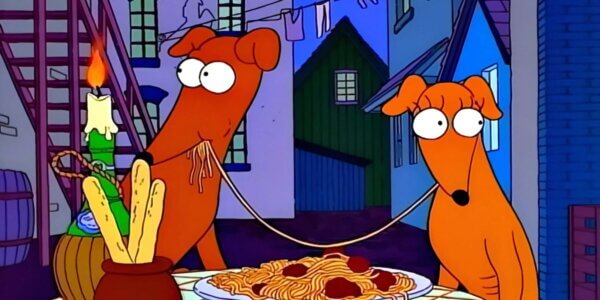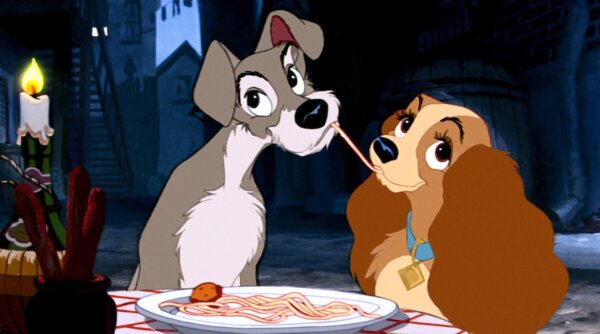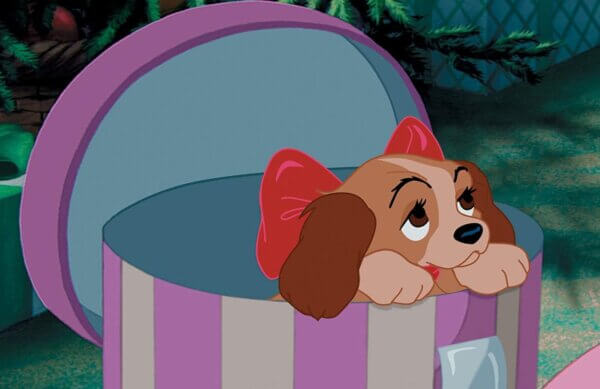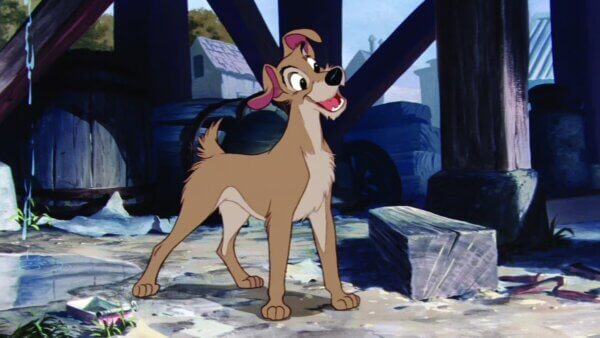Lady and the Tramp – 70 Years of Disney’s Beloved Canine Love Story
Premiering on the 16th of June of 1955, Walt Disney Animation Studios showed their 15th animated feature, Lady and the Tramp, in Chicago before being released across the rest of America on the 22nd that same month. A love story unlike anything they produced at the time, the film follows Lady, a cocker spaniel who lives a dog’s perfect life before her owners have a baby, shifting her dynamic in the family home. But a chance encounter with the street-wise homeless mutt simply known as Tramp will challenge and change both of their lives forever.
This romantic animated classic has enjoyed several re-releases at the cinema and home media over the years, becoming a beloved title among Disney’s animated films for multiple generations. But to get the film made, the animators, artists, and writers had a plethora of large obstacles ahead of them: from the people butting heads with Walt Disney himself on iconic scenes to artists having to adapt the film to new technology, to the different writers coming on board to change the trajectory of the story we all know and love.
To celebrate the 70th anniversary of Lady and the Tramp, I wanted to explore the artists and creative people who attempted to get the film made and look at not just how it impacted the animation industry, but how it impacted their careers and legacy as well.
Joe Grant’s Little Lady
After the release of Snow White and the Seven Dwarfs, character artist Joe Grant approached Walt Disney with an idea he had for a new potential story that the studio could animate. As well as being a character artist, Grant also came up with the stories for some of the short films that were part of the Silly Symphony series that they produced. He approached Disney with an idea based on his pet cocker spaniel and he encouraged Grant to develop the idea further, using the dynamics of his changing family life with the arrival of his child and how his beloved pet was pushed to the sidelines while the family juggled new responsibilities. Despite his attempts to get Disney onboard after presenting a series of storyboards and artwork, the idea was unfortunately scrapped and put away.
While Grant would resume his work as a character artist for Pinocchio and was one of the people responsible for the story behind Dumbo, Disney was reading the pages of Cosmopolitan, which was a literary magazine rather than the fashion publication it’s known as today, and read a short story named Happy Dan the Cynical Dog by Ward Greene. Enjoying the pessimistic pet in Greene’s story, Disney thought back about Grant’s Lady and decided to invite Greene to help create a treatment for a story where Grant’s Lady and Greene’s Dan would meet. But in 1943, pre-production for Lady and the Tramp had to be halted as Walt Disney Animation Studios were producing propaganda titles during the Second World War and because of this, the feature was placed in the dog house.
After the war ended, Walt Disney and his studio resumed their work in feature films with releases like The Adventures of Ichabod Crane and Mr. Toad. While Joe Grant would work on the story adaptations for Cinderella and Alice in Wonderland, he eventually left the studio in 1949 after the Character Model Department disbanded to set up his own ceramics business.
However, the studio revisited Lady and the Tramp, pulling out the early pre-production work, and resumed work on it after his absence. Ward Greene was invited back to write the novelization that was eventually released in 1953 after several members of the story team finished the script that same year. While they all received credit for the work, Joe Grant never got recognized for his contribution to the story and some of the characters despite his creation of Lady and its story on the dynamic surrounding the baby.
Teaching Nine Old Men New Tricks
When it came to bringing authenticity to the movement of characters in their earlier films like Bambi, the animators at Walt Disney Animation Studios studied animals to try and recreate realistic motion. With Lady and the Tramp, they brought in a plethora of dogs into the studio as well as filming them to create different references, with the core team of animators – Disney’s Nine Old Men – having to brush up on their experiences from Bambi to animate so many breeds that made up the large cast of canine characters with their unique personalities.
Each one of them not only helped to create some recognizable and iconic characters but also created some brilliantly beautiful sequences of early Disney animated titles. Eric Larson was responsible for Peg and animating her infamous “He’s a Tramp” song set at the dog pound in which he enjoyed collaborating and showing his work with voice actress and singer Peggy Lee to get the character right and match her performance; Woolie Reitherman was responsible for the dramatic action sequences, with Tramp’s fight against the intimidating and menacing rat being one of his stand out creations from his career; and Ollie Johnston animated Lady, brilliantly mixing dog characteristics with human humility and emotions simultaneously in one character.
But among these iconic scenes throughout the film, the Bella Notte scene is the most memorable from the film with its mix of romance, music, and beautiful animation while Tramp and Lady enjoy their meal together. However, Walt Disney thought that the scene would be too silly and unrealistic with the dogs enjoying a plate of spaghetti together, wanting to cut it out of the story entirely. Standing up against his decision, Frank Thomas took it upon himself to animate the entire sequence himself, showing off his talent that has lived on and easily became one of his most celebrated pieces of animated works.
The Artists Who Helped Create Cinemascope
Walt Disney Studios were no strangers when it came to embracing and inventing new technology that pushed filmmaking and cinematic experiences to new heights. Lady and the Tramp was no exception as it was their first film made for Cinescope, a lens system that implemented wide-screen footage, making films bigger on cinema screens and allowing them to add more into the expanded frame.
Different departments and designers were given a plethora of challenges to try and make the most of the new technology and implement it into production. Eyvind Earle was one of the main designers behind the Bella Notte scene, where Tramp and Lady explore the town and its surroundings after their romantic dinner. Even trained architect and set designer Claude Coats jumped into the task of creating larger sets head-on, creating miniature models to get the dogs’ perspectives when exploring the world around them.
But there was one other problem the studio had to contend with at the time of the film’s release; not all cinemas had screens capable of projecting Cinescope film reels. Therefore, they had to create two versions of the film, with the characters having to be moved around to fit them into the scenes and expanded the backgrounds so that there would be an anamorphic and widescreen version to accompany cinemas that had and didn’t have this new lens.
These Canines’ Legacy
Seventy years have passed since Lady and the Tramp premiered in American cinemas and ever since then, it has a lasting legacy in both animation films and cinematic romantic storytelling. More importantly, however, it also impacted the careers and legacy of some of those involved with the film as well.
Joe Grant did eventually return to Walt Disney Animation Studios in 1989, where he played a key role in helping to create the worlds and characters for the films that would spark the Disney Renaissance and beyond, including Beauty and the Beast, The Lion King, Pocahontas, and Mulan. While he may not have received credit for Lady and the Tramp, film historians and Disney enthusiasts recognize his contributions to the film and the key role he played in its origin.
Its impact was even cherished and valued outside the world of Walt Disney. This was often in the form of a parody of the famous Bella Notte scene and was referenced in countless iconic television shows, webtoons, and films, including The Simpsons, Rugrats in Paris: The Movie, Happy Tree Friends, The Amazing World of Gumball, and Teen Titans Go. While mostly parodies, the writers and animators of these numerous productions across a generation have shown how much this film and Frank Thomas’ nearly cut scene has impacted filmmakers decades down from when the world would be introduced to a love story unlike any other with such a simple yet visually captivating moment.

The Simpsons Parodied Lady and the Tramp in the Episode “Two Dozen and One Greyhounds.” Image sourced from CBR.
Recognized as not just one of the finest Disney animated classics but one of the best romantic films of all time, these talented members of Walt Disney Animation Studios were what made Lady and the Tramp such a technical and beautiful release for its time that still proudly holds itself up today. Whether it’s your hundredth time rewatching it or your first, let’s celebrate this piece of animation history and enjoy this joyous celebration of man’s best friend.




